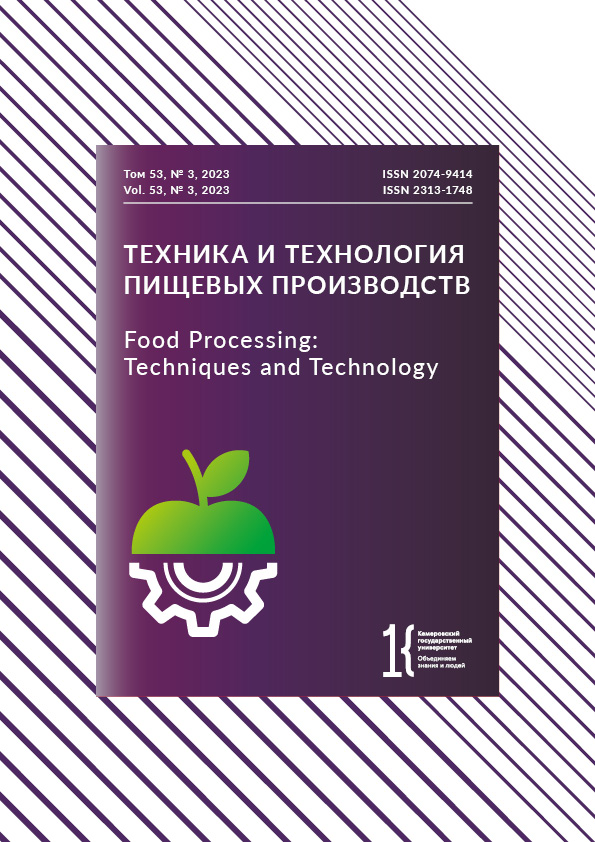Воронеж, Воронежская область, Россия
Воронеж, Воронежская область, Россия
Воронеж, Воронежская область, Россия
Воронеж, Воронежская область, Россия
Воронеж, Воронежская область, Россия
Воронеж, Воронежская область, Россия
с 01.01.2020 по настоящее время
Воронеж, Воронежская область, Россия
Воронеж, Воронежская область, Россия
Пробиотическая закваска – это биопрепарат на основе молочнокислых бактерий. Метаболические характеристики заквасок имеют значение для свойств ферментированных продуктов и определения потенциальной активности микроорганизмов. Цель исследования заключалась в оценке бактериального состава заквасочной культуры в различные промежутки времени в процессе ферментации при приготовлении пробиотического кисломолочного продукта. В исследовании использовали закваску для приготовления пробиотического кисломолочного продукта, включающую Streptococcus salivarius ssp. thermophiles, Lactobacillus delbrueckii ssp. bulgaricus, Bifidobacterium bifidum, Bifidobactreium animalis ssp. lactis, Bifidobacterium longum, Lactobacillus acidophilus и Lacticaseibacillus casei. Объектом ферментации являлось пастеризованное молоко. Отбор проб проводили на протяжении всего процесса ферментации (0, 3, 6, 9, 12, 15 и 18 ч). Для определения бактериального состава использовали метод секвенирования нового поколения, направленный на исследование V3 участка гена 16S рРНК. В процессе ферментации выявлено снижение Bifidobacterium и преобладание Lactobacillus. Пик их обильности в исследуемом субстрате составил 97,5 % на 15 ч ферментации. В каждой контрольной точке ферментации наблюдалось снижение численности Streptococcus. Род Lactobacillus заместил все другие роды бактерий, включая Bifidobacterium, что объясняется снижением pH в процессе ферментации. Для ферментации продолжительностью 18 ч были достигнуты оптимальные значения для увеличения численности рода Lactobacillus (рН = 4,2–4,4), но они оказались низкими для продуктивного роста Bifidobacterium. Проведенное исследование продемонстрировало динамику изменения бактериального состава молочной основы в процессе ферментации. Высокопроизводительное секвенирование является хорошим инструментом для контроля процессов ферментации пробиотиков.
Микробиом, пробиотический кисломолочный продукт, ферментация, заквасочная бактериальная культура, Lactobacillus, Bifidobacterium, Streptococcus, секвенирование 16S рРНК, индекс Шеннона
1. Leeuwendaal NK, Stanton C, O'Toole PW, Beresford TP. Fermented foods, health and the gut microbiome. Nutrients. 2022;14(7). https://doi.org/10.3390/nu14071527
2. Mathur H, Beresford TP, Cotter PD. Health benefits of lactic acid bacteria (LAB) fermentates. Nutrients. 2020;12(6). https://doi.org/10.3390/nu12061679 EDN: https://elibrary.ru/UQNPVC
3. Krasnova IS, Ganina VI, Semenov GV. Fruit and vegetable purees as cryoprotectants for vacuum freeze-dried fermented milk products. Foods and Raw Materials. 2023;11(2):300-308. https://doi.org/10.21603/2308-4057-2023-2-578 EDN: https://elibrary.ru/QORWKT
4. García-Díez J, Saraiva C. Use of starter cultures in foods from animal origin to improve their safety. International Journal of Environmental Research and Public Health. 2021;18(5). https://doi.org/10.3390/ijerph18052544 EDN: https://elibrary.ru/NBMUVS
5. Yang Q, Rutherfurd-Markwick K, Mutukumira AN. Identification of dominant lactic acid bacteria and yeast in rice sourdough produced in New Zealand. Current Research in Food Science. 2021;4:729-736. https://doi.org/10.1016/j.crfs.2021.10.002
6. Freitas M. The benefits of yogurt, cultures, and fermentation. In: Floch MH, Ringel Y, Walker WA, editors. The microbiota in gastrointestinal pathophysiology. Implication human health, prebiotics, probiotics, dysbiosis. Academic Press; 2017. pp. 209-223. https://doi.org/10.1016/B978-0-12-804024-9.00024-0
7. İspirli H, Dertli E. Isolation and identification of exopolysaccharide producer lactic acid bacteria from Turkish yogurt. Journal of Food Processing and Preservation. 2018;42(8). https://doi.org/10.1111/jfpp.13351
8. Agustinah W, Warjoto RE, Canti M. Yogurt making as a tool to understand the food fermentation process for nonscience participants. Journal of Microbiology and Biology Education. 2019;20(1). https://doi.org/10.1128/jmbe.v20i1.1662
9. Saarela M, Mogensen G, Fondén R, Mättö J, Mattila-Sandholm T. Probiotic bacteria: safety, functional and technological properties. Journal of Biotechnology. 2000;84(3):197-215. https://doi.org/10.1016/s0168-1656(00)00375-8 EDN: https://elibrary.ru/LREFST
10. Viability of probiotic Lactobacillus casei in yoghurt: defining the best processing step to its addition [Internet]. [cited 2023 Jan 16]. Available from: https://www.alanrevista.org/ediciones/2013/1/art-8
11. Gao J, Li X, Zhang G, Sadiq FA, Simal-Gandara J, Xiao J, et al. Probiotics in the dairy industry - Advances and opportunities. Comprehensive Reviews in Food Science and Food Safety. 2021;20(4):3937-3982. https://doi.org/10.1111/1541-4337.12755 EDN: https://elibrary.ru/KAEDKF
12. Widyastuti Y, Febrisiantosa A, Tidona F. Health-promoting properties of lactobacilli in fermented dairy products. Frontiers in Microbiology. 2021;12. https://doi.org/10.3389/fmicb.2021.673890 EDN: https://elibrary.ru/JQQUHW
13. Amanat S, Mazloomi SM, Asadimehr H, Sadeghi F, Shekouhi F, Mortazavi SMJ. Lactobacillus acidophilus and Lactobacillus casei exposed to Wi-Fi radiofrequency electromagnetic radiation show enhanced growth and lactic acid production. Journal of Biomedical Physics and Engineering. 2020;10(6):745-750. https://doi.org/10.31661/JBPE.V0I0.1056 EDN: https://elibrary.ru/BIRFLL
14. Fijan S. Microorganisms with claimed probiotic properties: An overview of recent literature. International Journal of Environmental Research Public Health. 2014;11(5):4745-4767. https://doi.org/10.3390/ijerph110504745 EDN: https://elibrary.ru/YEVBUT
15. Cai J, Bai J, Luo B, Nio Y, Tian E, Yan W. In vitro evaluation of probiotic properties and antioxidant activities of Bifidobacterium strains from infant feces in the Uyghur population of northwestern China. Annals of Microbiology. 2022;72. https://doi.org/10.1186/s13213-022-01670-y EDN: https://elibrary.ru/DBCIXN
16. O’Sullivan A, Farver M, Smilowitz JT. The influence of early infant-feeding practices on the intestinal microbiome and body composition in infants. Nutrition and Metabolic Insights. 2015;8(1). https://doi.org/10.4137/NMI.S29530
17. Cheng J, Laitila A, Ouwehand AC. Bifidobacterium animalis subsp. lactis HN019 effects on gut health: A review. Frontiers in Nutrition. 2021;8. https://doi.org/10.3389/fnut.2021.790561
18. Parhi P, Song KP, Choo WS. Growth and survival of Bifidobacterium breve and Bifidobacterium longum in various sugar systems with fructooligosaccharide supplementation. Journal of Food Science and Technology. 2022;59:3775-3786. https://doi.org/10.1007/s13197-022-05361-z
19. Mills S, Yang B, Smith GJ, Stanton C, Ross RP. Efficacy of Bifidobacterium longum alone or in multi-strain probiotic formulations during early life and beyond. Gut Microbes. 2023;15(1). https://doi.org/10.1080/19490976.2023.2186098
20. Salari A, Hashemi M, Afshari A. Functional properties of kefiran in the medical field and food Industry. Current Pharmaceutical Biotechnology. 2022;23(3):388-395. https://doi.org/10.2174/1389201022666210322121420 EDN: https://elibrary.ru/IUARVK
21. Landis EA, Oliverio AM, McKenney EA, Nichols LM, Kfoury N, Biango-Daniels, et al. The diversity and function of sourdough starter microbiomes. eLife. 2021;10. https://doi.org/10.7554/ELIFE.61644
22. Savaiano DA, Hutkins RW. Yogurt, cultured fermented milk, and health: A systematic review. Nutrition Reviews. 2021;79(5):599-614. https://doi.org/10.1093/NUTRIT/NUAA013
23. Salazar JK, Gonsalves LJ, Fay M, Ramachandran P, Schill KM, Tortorello ML. Metataxonomic profiling of native and starter microbiota during ripening of gouda cheese made with Listeria monocytogenes-contaminated unpasteurized milk. Frontiers in Microbiology. 2021;12. https://doi.org/10.3389/fmicb.2021.642789
24. Chessa L, Paba A, Dupré I, Daga E, Fozzi MC, Comunian R. Strategy for the recovery of raw ewe's milk microbiodiversity to develop natural starter cultures for traditional foods. Microorganisms. 2023;11(4). https://doi.org/10.3390/microorganisms11040823
25. Wu Y, Li Y, Gesudu Q, Zhang J, Sun Z, Halatu H, et al. Bacterial composition and function during fermentation of Mongolia koumiss. Food Science and Nutrition. 2021;9(8):4146-4155. https://doi.org/10.1002/fsn3.2377
26. Maleke M, Doorsamy W, Abrahams AM, Adefisoye MA, Masenya K, Adebo OA. Influence of fermentation conditions (temperature and time) on the physicochemical properties and bacteria microbiota of amasi. Fermentation. 2022;8(2). https://doi.org/10.3390/fermentation8020057
27. Zhu L, Hou Z, Hu X, Liu X, Dai T, Wang X, et al. Genomic and metabolic features of an unexpectedly predominant, thermophilic, assistant starter microorganism, Thermos thermophilus, in Chinese inner Mongolian cheese. Foods. 2021;10(12). https://doi.org/10.3390/foods10122962 EDN: https://elibrary.ru/AIFTBH
28. Lee HW, Kim IS, Kil BJ, Seo E, Park H, Ham J-S, et al. Investigation of flavor-forming starter Lactococcus lactis subsp. lactis LDTM6802 and Lactococcus lactis subsp. cremoris LDTM6803 in miniature gouda-type cheeses. Journal of Microbiology and Biotechnology. 2020;30(9):1404-1411. https://doi.org/10.4014/jmb.2004.04004
29. Huang F, Sardari RRR, Jasilionis A, Böök O, Öste R, Rascón A, et al. Cultivation of the gut bacterium Prevotella copri DSM 18205T using glucose and xylose as carbon sources. MicrobiologyOpen. 2021;10(3). https://doi.org/10.1002/MBO3.1213
30. Verbrugghe P, Brynjólfsson J, Jing X, Björck I, Hållenius F, Nilsson A. Evaluation of hypoglycemic effect, safety and immunomodulation of Prevotella copri in mice. Scientific Reports. 2021;11. https://doi.org/10.1038/s41598-021-96161-6
31. Shah NP. Bacteria, beneficial | Bifidobacterium spp.: Morphology and physiology. In: Fuquay JW, editor. Encyclopedia of dairy sciences. Academic Press; 2011. pp. 381-387. https://doi.org/10.1016/B978-0-12-374407-4.00043-1
32. Song X, Hou C, Yang Y, Ai L, Xia Y, Wang G, et al. Effects of different carbon sources on metabolic profiles of carbohydrates in Streptococcus thermophilus during fermentation. Journal of the Science of Food and Agriculture. 2022;102(11):4820-4829. https://doi.org/10.1002/jsfa.11845
33. Liu G, Qiao Y, Zhang Y, Leng C, Chen H, Sun J, et al. Metabolic profiles of carbohydrates in Streptococcus thermophilus during pH-controlled batch fermentation. Frontiers in Microbiology. 2020;11. https://doi.org/10.3389/fmicb.2020.01131
34. Pi X, Yang Y, Sun Y, Cui Q, Wan Y, Fu G, et al. Recent advances in alleviating food allergenicity through fermentation. Critical Reviews in Food Science and Nutrition. 2022;62(26):7255-7268. https://doi.org/10.1080/10408398.2021.1913093 EDN: https://elibrary.ru/DWJAFM
35. Ye M, Xu Z, Tan H, Yang F, Yuan J, Wu Y, et al. Allergenicity reduction of cow milk treated by alkaline protease combined with Lactobacillus plantarum and Lactobacillus helveticus based on epitopes. Food Chemistry. 2023;421. https://doi.org/10.1016/j.foodchem.2023.136180
36. Chen JM, Al KF, Craven LJ, Seney S, Coons M, McCormick H, et al. Nutritional, microbial, and allergenic changes during the fermentation of cashew “cheese” product using a quinoa-based rejuvelac starter culture. Nutrients. 2020;12(3). https://doi.org/10.3390/nu12030648
37. Gao J, Li X, Zhang G, Sadiq FA, Simal-Gandara J, Xiao J, et al. Probiotics in the dairy industry - Advances and opportunities. Comprehensive Reviews in Food Science and Food Safety. 2021;20(4):3937-3982. https://doi.org/10.1111/1541-4337.12755 EDN: https://elibrary.ru/KAEDKF
38. Syromyatnikov M, Nesterova E, Gladkikh M, Popov V. Probiotics analysis by high-throughput sequencing revealed multiple mismatches at bacteria genus level with the declared and actual composition. LWT. 2022;156. https://doi.org/10.1016/j.lwt.2021.113055 EDN: https://elibrary.ru/WUGABU
39. Syromyatnikov MYu, Korneeva OS, Nesterova EYu, Gladkikh MI, Popov ES, Popov VN. High-throughput sequencing of the 16S rRNA gene for evaluation the composition of bacterial starter cultures used for the preparation of fermented milk products. Biotechnology in Russia. 2022;38(1):80-92. (In Russ.). https://doi.org/10.56304/S0234275822010082 EDN: https://elibrary.ru/QUFMIH











